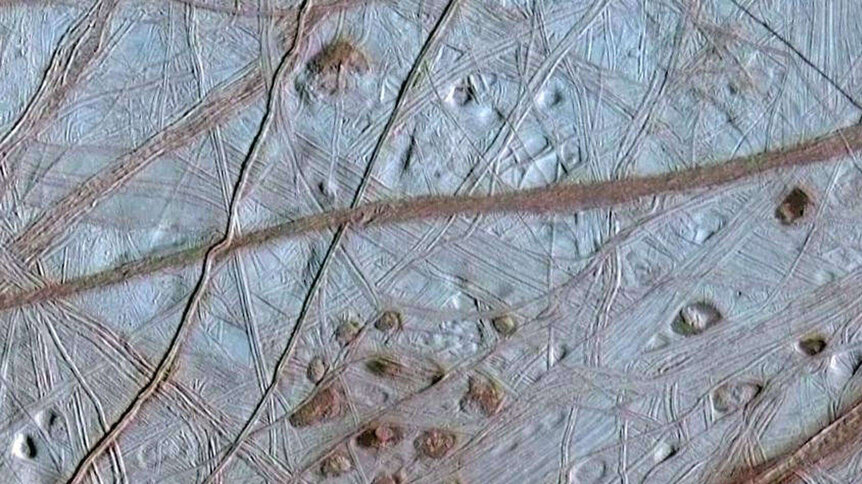Create a free profile to get unlimited access to exclusive videos, sweepstakes, and more!
Volcanoes deep inside frozen moon Europa could mean a hotbed of life

Europa seems like a hostile place. You can expect an average daytime high of -225 degrees Fahrenheit—and that isn’t even at the poles—but its frozen face might be hiding unexpected warmth deep inside.
Far below the miles of ice and rocks that make up Europa’s crust, its subsurface ocean could be bubbling with volcanic activity that may have been going on for as long as 4.5 billion years. This might have made Europa’s subsurface ocean a place for life (at least as we know it) to thrive without being exposed to harsh radiation and other hazards of crawling on the surface. It also made geophysicist Marie Běhounková, of Charles University in the Czech Republic, wonder how likely it is that Europa is heated by molten magma in places beyond the reach of the Sun.
“Many scientists have been modeling of the tidal dissipation and heat transfer in planetary bodies for many decades,” Běhounková, who recently published a study in Geophysical Research Letters told SYFY WIRE in an interview. "My team and I started ten years ago and recently tailored our model for Europa."
Earth has hydrothermal vents gushing hot water in the hadal depths of the ocean, where the pressure is too high and the temperature is too low for most life-forms, except some exceptionally strange creatures, to survive. Scenes like this mean it isn’t beyond the realm of science to imagine something similar on (or this case in) Europa. Hypothetical life on Jupiter’s moon of ice might be similar to the bacterial mats, lipstick worms and bioluminescent fish that thrive in our planet’s dark oases. This is no place for photosynthesis; algae cannot bloom without sunlight. What life in these alien places relies on instead is chemosynthesis.
In the blackest reaches of the ocean floor where sunlight cannot penetrate, bacteria that form thick mats near hydrothermal vents are fueled by the energy of chemical reactions that occur as a part of the geochemistry of the abyssal and hadal zones. Bacteria that swarm around the submerged geysers are chemosynthetic organisms that convert inorganic substances into food. They are able to produce a sugar after oxidizing hydrogen sulfide and adding CO2 and oxygen to it. Food means they have competition, not to mention predators, because anything edible is scarce except for the occasional dead thing sinking to the bottom.
With the Jovian moon Io being the most volcanic world in the solar system, since the interior gets fired up with Jupiter and possibly its other moons continuously pulling at it, Europa could be similarly affected. Běhounková and her team had their doubts because Europa is further away from Jupiter than the temperamental Io. To see if it is possible that gravity from the gas giant and its other moons could still play into making Europa volcanic, they created models that simulated how the inside of the moon evolved since its birth. What they found was surprising for a moon whose eternal winter is reminiscent of The Chronicles of Narnia.
Europa is thought to have started getting warmer when the decay of radioactive elements in its mantle released a massive amount of heat. Jupiter also exerts tidal forces that lead to volcanism. The moon, named after a mortal woman seduced by king of the gods Jupiter (Zeus) in Greco-Roman mythology, orbits close enough to feel the heat when those tidal forces keep pulling at its interior. Enough heat results from this for Europa to have a heart of liquid magma that might be powering undersea volcanoes.
"Radionuclide elements are unstable atoms with excess nuclear energy
they can release," Běhounková said. "Radionuclides occur naturally in the building blocks of planets and moons. During accretion, they are incorporated
in their interiors, especially in the rocky part of bodies. They can
help heat up the interior of planets and moons, and on
Europa, they can help to keep the ocean from freezing."
ESA’s Jupiter Icy Moons Explorer (JUICE) and NASA’s Europa Clipper mission will find out whether Europa really does have volcanoes, and possibly some extraterrestrial form of life, after they take off for the moon where it is always winter. That would be next year for JUICE and 2024 for Europa Clipper. Běhounková is optimistic about both.
"All the JUICE and Europa Clipper results will be exciting," "Measuring Europa's orbit could help detect gravitational anomalies at high latitudes, and the presence of hydrothermally derived elements changes may confirm seafloor activity."
Until then, the questions of whether life actually exists and what it could look like are questions that will remain floating in space.



























